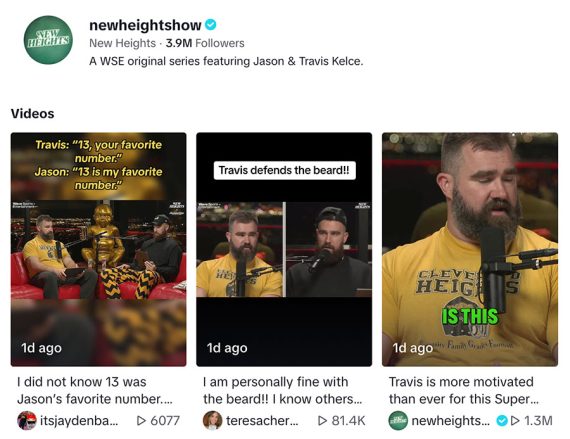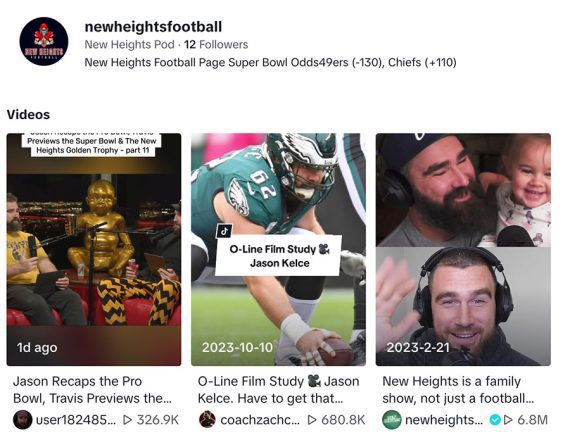Wide-base Strategy for Short-form Videos
TikTok’s algorithm surfaces new accounts. This has led some marketers to take a “wide-base” or “horizontal” approach to short-form video promotion.
With this tactic, a business owns several TikTok accounts. Each publishes the same or similar videos. The tactic aims to earn more total views than if the company had shared these short-form videos only on a single account.
New Heights
The wide-base account strategy appears most common with content creators.
For example, consider Travis and Jason Kelce’s “New Heights” podcast, one of the most popular U.S. sports-related shows.




“New Heights Show” is one of the most popular sports channels in the United States.
The show’s primary TikTok account, @newheightshow, has 3.9 million followers.
According to an individual familiar with the podcast, several other accounts publish the show’s content under different names, such as @newheightsfootball, @newheightsrewind, and @newheightsclips.






“New Heights Football” publishes nearly the same content as “New Heights Show.”
Views before Followers
The wide-base strategy aims to get more views and earn more followers. The approach is noteworthy because the primary metric is how many times folks watch the content. The follower count — often the lead KPI for social media marketing — is secondary.
A hypothetical example might help. Imagine you are the marketer at Fee Brothers, a brand that makes cocktail bitters and egg replacers for drinks such as the classic whiskey sour.
Your content marketing efforts include a series of cocktail recipe videos.
The recipe videos are relatively long and published on X and YouTube. And each episode is sliced up into short clips. With the wide-base strategy, the brand would release those clips under several unique, albeit small, accounts.
TikTok’s algorithm would surface all the videos to relevant users, expanding or widening the impact. Fee Brother’s primary account may receive the most views, but the wide-base accounts would contribute, too.
If the aim is to sell more cocktail bitters and egg replacers, more video views could lead to more customers visiting the brand’s online shop. Mission accomplished.
Secondarily, those short-form clips introduce viewers to the long-form recipe show and the primary Fee Brothers account.
Account Ideas
Publishing identical clips on multiple accounts is likely effective, but a little variety doesn’t hurt either. Here is an example.
- Primary account. Named after the business, this account publishes all of the clips and may have its handle (name) shown on the clips.
- “Clips” account. This one has a handle such as “FeeBrothersClips.” It republishes just about everything from the primary account.
- “Fans” account. This one also republishes nearly everything from the primary account.
- “Best of” account. Named with “best” or “bestof” in the handle, it publishes top-performing and high-priority clips.
- “Mistakes” account. This account shares clips featuring bloopers or behind-the-scenes action from the primary show. These clips may be unique, sharing the message and implied product promotion.
Follow a similar pattern to create a wide base of small accounts.
Short-form How-to
Marketers should monitor short-form views across all accounts. Follower count, the secondary KPI, is measured only for the primary account.
To connect views to sales, include a coupon code in the clips or otherwise track when clips correspond to increases in traffic and transactions.
For best wide-based results:
- Use the proper format. Even if your primary videos are in a standard horizontal format, make vertical clips for TikTok, Instagram Reels, YouTube Shorts, Snapchat, and X videos.
- Have a clear hook to grab attention. This might be an image, the video clip’s title, or a thumbnail.
- Keep it short. Seasoned marketers typically recommend 11-to-17 seconds for TikTok, about 10 seconds for Instagram Reels, and up to a minute for YouTube Shorts, X, and Snapchat.
- Post consistently. Short-form video platforms often have a target cadence. WordStream, an agency, recommends publishing one to four times daily for each TikTok account.
- Show products in use. Remember the hypothetical Fee Brothers example. A long-form cocktail recipe shows the company’s bitters in use. Do the same whether you sell clothes or power tools.
- Use humor. A short-form video is often best when it is funny and informative. Don’t be afraid to make viewers laugh.
Execution
This wide-base video clip strategy is meant to produce relatively more short-form video views than a business can generate from a single account. It appears to work best on TikTok, although it’s worth testing on any social media network.











